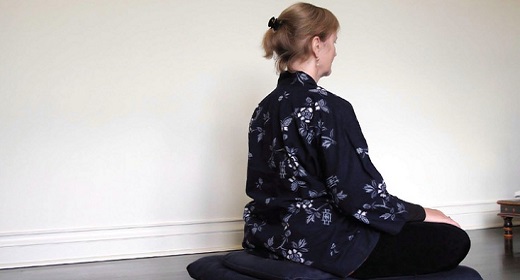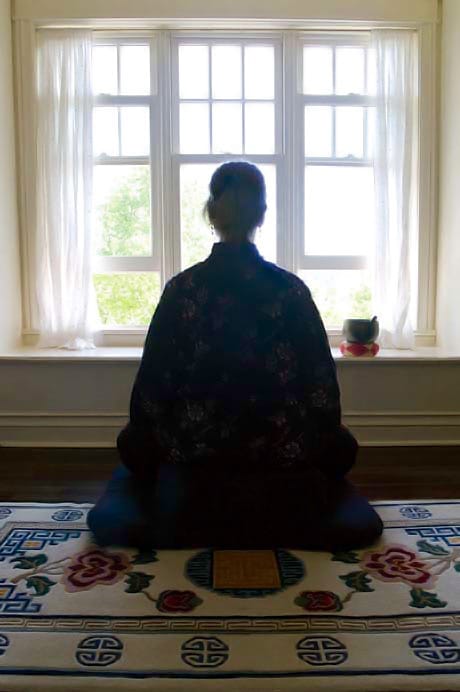by Matthieu Ricard: Matthieu Ricard answers everyone’s first question…

Take an honest look at yourself. Where are you in your life? What have your priorities been up till now and what do you intend to do with the time you have left? We are a mixture of light and shadow, of good qualities and defects. Are we really the best we can be? Must we remain as we are now? If not, what can we do to improve ourselves? These are questions worth asking, particularly if we have come to the conclusion that change is both desirable and possible.
Every one of us has a mind and every one of us can work on it.
In our modern world, we are consumed from morning till night with endless activity. We do not have much time or energy left over to consider the basic causes of our happiness or suffering. We imagine, more or less consciously, that if we undertake more activities we will have more intense experiences and therefore our sense of dissatisfaction will fade away. But the truth is that many of us continue to feel let down and frustrated by our contemporary lifestyle.
The aim of meditation is to transform the mind. It does not have to be associated with any particular religion. Every one of us has a mind and every one of us can work on it.
Is change possible?
The real question is not whether change is desirable; it is whether it is possible to change. Some people might think they can’t change because their afflictive emotions are so intimately associated with their minds that it is impossible to get rid of them without destroying a part of themselves.
It is true that in general a person’s character doesn’t change very much over the course of their life. If we could study the same group of people every few years, we would rarely find that the angry people had become patient, that the disturbed people had found inner peace, or that the pretentious people had learned humility. But as rare as such changes might be, some people do change, which shows that change is possible. The point is that our negative character traits tend to persist if we do nothing at all to change the status quo. No change occurs if we just let our habitual tendencies and automatic patterns of thought perpetuate and even reinforce themselves, thought after thought, day after day, year after year. But those tendencies and patterns can be challenged.
No change can occur if we just let our habitual tendencies perpetuate and even reinforce themselves, thought after thought, day after day, year after year.
Aggression, greed, jealousy, and the other mental poisons are unquestionably part of us, but are they an intrinsic, inalienable part? Not necessarily. For example, a glass of water might contain cyanide that could kill us on the spot. But the same water could instead be mixed with healing medicine. In either case, H2O, the chemical formula of the water itself, remains unchanged; in itself, it was never either poisonous or medicinal. The different states of the water are temporary and dependent on changing circumstances. In a similar way, our emotions, moods, and bad character traits are just temporary and circumstantial elements of our nature.
A fundamental aspect of consciousness
This temporary and circumstantial quality becomes clear to us when we realize that the primary quality of consciousness is simply knowing. Like the water in the above example, knowing or awareness is neither good nor bad in itself. If we look behind the turbulent stream of transient thoughts and emotions that pass through our minds day and night, this fundamental aspect of consciousness is always there. Awareness makes it possible for us to perceive phenomena of every kind. Buddhism describes this basic cognitive quality of the mind as luminous because it illuminates both the external world through perceptions and the inner world of sensation, emotion, reasoning, memory, hope, and fear.
Although this cognitive faculty underlies every mental event, it is not itself affected by any of these events. A ray of light may shine on a face disfigured by hatred or on a smiling face; it may shine on a jewel or on a garbage heap; but the light itself is neither mean nor loving, neither dirty nor clean. Understanding that the essential nature of consciousness is neutral shows us that it is possible to change our mental universe. We can transform the content of our thoughts and experiences. The neutral and luminous background of our consciousness provides us with the space we need to observe mental events rather than being at their mercy. We then also have the space we need to create the conditions necessary to transform these mental events.
Wishing is not enough
We have no choice about what we already are, but we can wish to change ourselves. Such an aspiration gives the mind a sense of direction. But just wishing is not enough. We have to find a way of putting that wish into action.
We don’t find anything strange about spending years learning to walk, read and write, or acquire professional skills. We spend hours doing physical exercises to get our bodies into shape. Sometimes we expend tremendous physical energy pedaling a stationary bike. To sustain such tasks requires a minimum of interest or enthusiasm. This interest comes from believing that these efforts are going to benefit us in the long run.
Working with the mind follows the same logic. How could it be subject to change without the least effort, just from wishing alone? That makes no more sense than expecting to learn to play a Mozart sonata by just occasionally doodling around on the piano.
If we transform our way of perceiving things, we transform the quality of our lives.
We expend a lot of effort to improve the external conditions of our lives, but in the end it is always the mind that creates our experience of the world and translates this experience into either well-being or suffering.
If we transform our way of perceiving things, we transform the quality of our lives. It is this kind of transformation that is brought about by the form of mind training known as meditation.
What is meditation?

Meditation is a practice that makes it possible to cultivate and develop certain basic positive human qualities in the same way as other forms of training make it possible to play a musical instrument or acquire any other skill.
Among several Asian words that translate as “meditation” in English are bhavana from Sanskrit, which means “to cultivate,” and its Tibetan equivalent, gom, meaning “to become familiar with.” Meditation helps us to familiarize ourselves with a clear and accurate way of seeing things and to cultivate wholesome qualities that remain dormant within us unless we make an effort to draw them out.
So let us begin by asking ourselves, “What do I really want out of life? Am I content to just keep improvising from day to day? Am I going to ignore the vague sense of discontent that I always feel deep down when, at the same time, I am longing for well-being and fulfillment?” We have become accustomed to thinking that our shortcomings are inevitable and that we have to put up with the setbacks they have brought us throughout our lives. We take the dysfunctional aspects of ourselves for granted, not realizing that it is possible to break out of the vicious cycle of exhausting behavior patterns.
From a Buddhist point of view, the traditional texts say every being has the potential for enlightenment just as surely as every sesame seed contains oil. Despite this, to use another traditional comparison, we wander about in confusion like a beggar who is simultaneously rich and poor because he does not know he has a treasure buried under the floor of his hut. The goal of the Buddhist path is to come into possession of this overlooked wealth of ours, which can imbue our lives with the most profound meaning.
Training the mind
The object of meditation is the mind. For the moment, it is simultaneously confused, agitated, rebellious, and subject to innumerable conditioned and automatic patterns. The goal of meditation is not to shut down the mind or anesthetize it, but to make it free, lucid, and balanced.
Training the mind is crucial if we want to refine and sharpen our attention; develop emotional balance, inner peace, and wisdom; and cultivate dedication to the welfare of others.
According to Buddhism, the mind is not an entity but rather a dynamic stream of experiences, a succession of moments of consciousness. These experiences are often marked by confusion and suffering, but we can also live them in a spacious state of clarity and inner freedom.
We all well know, as the contemporary Tibetan master Jigme Khyentse Rinpoche reminds us, that “we don’t need to train our minds to improve our ability to get upset or jealous. We don’t need an anger accelerator or a pride amplifier.” By contrast, training the mind is crucial if we want to refine and sharpen our attention; develop emotional balance, inner peace, and wisdom; and cultivate dedication to the welfare of others. We have within ourselves the potential to develop these qualities, but they will not develop by themselves or just because we want them to. They require training. And all training requires perseverance and enthusiasm, as I have already said. We won’t learn to ski by practicing one or two minutes a month.
Refining attention and mindfulness
Galileo discovered the rings of Saturn after devising a telescope that was sufficiently bright and powerful and setting it up on a stable support. His discovery would not have been possible if his instrument had been inadequate or if he had held it in a trembling hand. Similarly, if we want to observe the subtlest mechanisms of our mental functioning and have an effect on them, we absolutely must refine our powers of looking inward. In order to do that, our attention has to be highly sharpened so that it becomes stable and clear. We will then be able to observe how the mind functions and perceives the world, and we will be able to understand the way thoughts multiply by association. Finally, we will be able to continue to refine the mind’s perception until we reach the point where we are able to see the most fundamental state of our consciousness, a perfectly lucid and awakened state that is always present, even in the absence of the ordinary chain of thoughts.
What meditation is not
Sometimes practitioners of meditation are accused of being too focused on themselves, of wallowing in egocentric introspection and failing to be concerned with others. But we cannot regard as selfish a process whose goal is to root out the obsession with self and to cultivate altruism. This would be like blaming an aspiring doctor for spending years studying medicine before beginning to practice.
There are a fair number of clichés in circulation about meditation. Let me point out right away that meditation is not an attempt to create a blank mind by blocking out thoughts—which is impossible anyway. Nor is it engaging the mind in endless cogitation in an attempt to analyze the past or anticipate the future. Neither is it a simple process of relaxation in which inner conflicts are temporarily suspended in a vague, amorphous state of consciousness. There is not much point in resting in a state of inner bewilderment. There is indeed an element of relaxation in meditation, but it is connected with the relief that comes from letting go of hopes and fears, of attachments and the whims of the ego that never stop feeding our inner conflicts.
Mastery that sets us free
The way we deal with thoughts in meditation is not to block them or feed them indefinitely, but to let them arise and dissolve by themselves in the field of mindfulness. In this way, they do not take over our minds. Beyond that, meditation consists of cultivating a way of being that is not subject to the patterns of habitual thinking. It often begins with analysis and then continues with contemplation and inner transformation. To be free is to be the master of ourselves. It is not a matter of doing whatever comes into our heads, but rather of freeing ourselves from the constraints and afflictions that dominate and obscure our minds. It is a matter of taking our life into our own hands rather than abandoning it to the tendencies created by habit and mental confusion. Instead of letting go of the helm and just allowing the boat to drift wherever the wind blows, freedom means setting a course toward a chosen destination—the destination that we know to be the most desirable for ourselves and others.
The heart of reality
Meditation is not, as some people think, a means of escaping reality. On the contrary, its object is to make us see reality as it is, right in the midst of our experience, to unmask the deep causes of our suffering, and to dispel mental confusion. We develop a kind of understanding that comes from a clearer view of reality. To reach this understanding, we meditate, for example, on the interdependence of all phenomena, on their transitory character, and on the nonexistence of the ego perceived as a solid and independent entity.
There is indeed an element of relaxation in meditation, but it is connected with the relief that comes from letting go of hopes and fears, of attachments and the whims of the ego that never stop feeding our inner conflicts.
Meditations on these themes are based on the experience of generations of meditators who have devoted their lives to observing the automatic, mechanical patterns of thought and the nature of consciousness. They then taught empirical methods for developing mental clarity, alertness, inner freedom, altruistic love, and compassion. However, we cannot merely rely on their words to free ourselves from suffering. We must discover for ourselves the value of the methods these wise people taught and confirm for ourselves the conclusions they reached. This is not purely an intellectual process. Long study of our own experience is needed to rediscover their answers and integrate them into ourselves on a deep level. This process requires determination, enthusiasm, and perseverance. It requires what Shantideva calls “joy in virtuous ways.”
Thus we begin by observing and understanding how thoughts multiply by association with each other and create a whole world of emotions, of joy and suffering. Then we penetrate the screen of thoughts and glimpse the fundamental component of consciousness: the primal cognitive faculty from which all thoughts arise.
Liberating monkey mind
To accomplish this task, we must begin by calming our turbulent mind. Our mind behaves like a captive monkey who, in his agitation, becomes more and more entangled in his bonds.
Out of the vortex of our thoughts, first emotions arise, and then moods and behaviors, and finally habits and traits of character. What arises spontaneously does not necessarily produce good results, any more than throwing seeds into the wind produces good harvests. So we have to behave like good farmers who prepare their fields before sowing their seeds. For us, this means the most important task is to attain freedom through mastering our mind.
If we consider that the potential benefit of meditation is to give us a new experience of the world each moment of our lives, then it doesn’t seem excessive to spend at least twenty minutes a day getting to know our mind better and training it toward this kind of openness. The fruition of meditation could be described as an optimal way of being, or as genuine happiness. This true and lasting happiness is a profound sense of having realized to the utmost the potential we have within us for wisdom and accomplishment. Working toward this kind of fulfillment is an adventure worth embarking on.








































